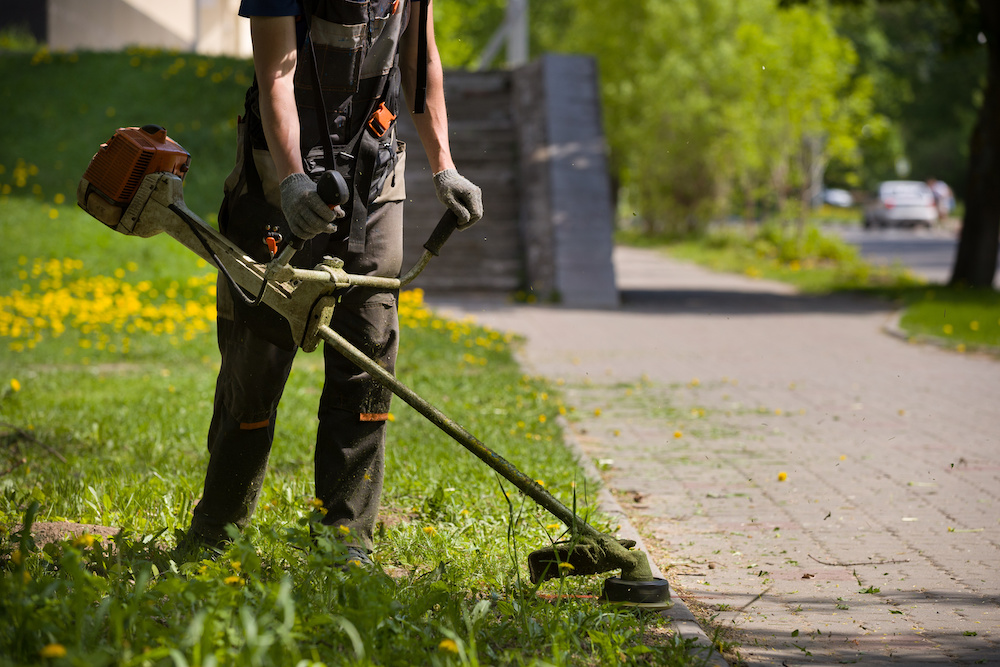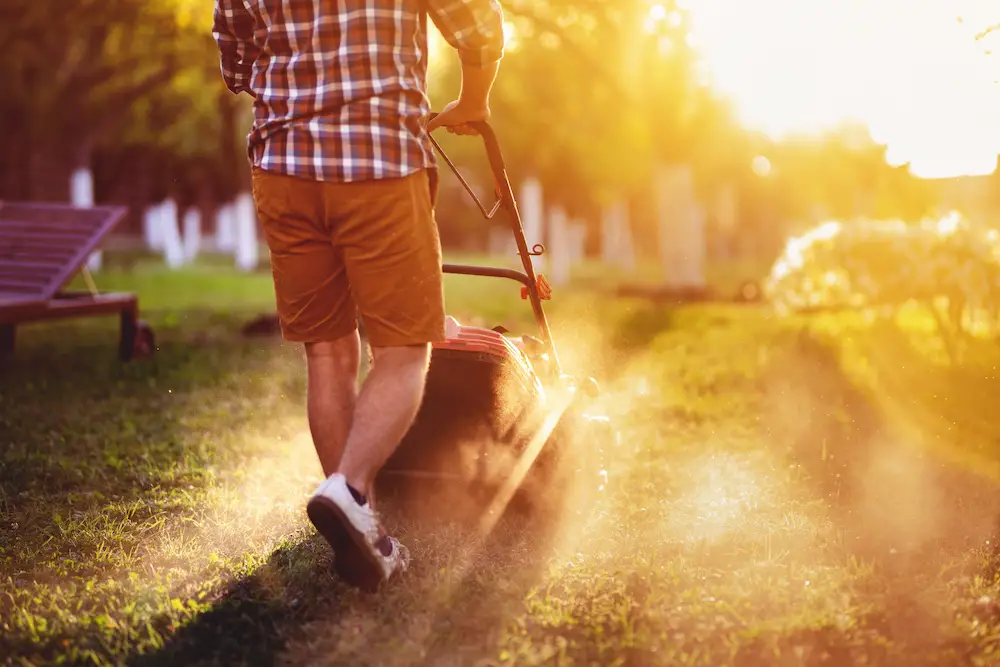Maintaining a lawn is fun, but it isn’t an easy feat. Until you roll your sleeves up and get your hands into the dirt, you’ll never know how many questions you have about lawn care.
You probably have so many concerns about keeping your yard beautiful. One of which is about the best time of day to mow lawn in hot weather conditions.
You might be asking things like how do you ensure that your turf stays green and healthy or how often should you mow in the summer? Relax and take a deep, cleansing breath.
We’ve got you covered. We’ll walk you through the art of lawn care in hot weather. Plus, we’ll give you practical tips for keeping your turf beautiful throughout the summer season.
Best Time of Day to Mow Lawn in Hot Weather
The best time to mow lawn in hot weather is mid-morning or late afternoon.
At these times, the grass has had enough time to dry from the previous night’s dew. At the same time, you won’t be dealing with scourging heat that could burn your skin.
Early Morning
You might be wondering, how about early morning? Wouldn’t it be a perfect time for you since the sun isn’t out yet?
Yes, it may be more convenient for you, but early morning isn’t the best time to mow the lawn since the grass is still wet from the evening dew. It isn’t good because wet grass clippings can clog your lawn mower and damage your machine.
Also, if left unraked, the wet clumps will smother and kill the grass they cover, resulting in dead spots. Another reason it isn’t a good idea to mow the lawn early in the morning is that it could compromise your lawn’s health.
If there’s a disease in your lawn, you risk spreading the disease around the yard. Furthermore, mowing the lawn early in the morning is a big no-no because wet grass is slippery.
You might fall while pushing a running mower, especially if you have a sloped lawn. Also, the soil is still wet at this time, and you are likely to create unsightly wheel ruts or tire marks on your lawn when you mow.
Consequently, it can tear up the grass. Lastly, mowing when the grass is wet can cause stains on your clothes and shoes, which can be difficult to clean up.
Mid-Morning
Mid-morning or between eight and 10 in the morning is one of the best times to mow the lawn in hot weather. At this time, the morning dew has dried, and the temperature hasn’t peaked yet, even in very hot seasons.
Also, by mowing the lawn in mid-morning, you allow your lawn to recover before it gets exposed to the hot afternoon sun or the cool evening air. If your property has a lot of shade, you might need to wait longer for the previous night’s dew to evaporate completely.
Avoid mowing grass between 10 am and 4 pm. This period is the worst time for cutting grass, as it is dangerous for you and your turf.
At midday, the grass is busy photosynthesizing and keeping hold of its moisture. Hence, if you cut it when the sun is at its peak, you are ruining this fundamental process, which can further damage your lawn.
You shouldn’t also edge your lawn at this time because it makes the grass turn brown as the sun dries it out. If you mow your lawn at this time, the afternoon sun will leave the grass blades dry and damaged.
Health-wise, this time of the day is the best time to get a nasty sunburn. You also run the risk of dehydration as you sweat and soak in the heat.
Late in the Afternoon
Don’t have time in the morning? It’s fine.
You still have late afternoon to mow your lawn; the second-best time to mow a lawn is between 5 pm and 6 pm.
The afternoon isn’t as bright, and the temperatures have started to drop. Thus, your lawn will have enough time to recover before nightfall.
If you live in an area where it’s extremely hot during the day, late afternoon is the ideal time to mow your lawn.
Evening
Sundown might feel like a great time to mow the lawn because the air is cool and cozy. Unfortunately, this time comes with its own risks too.
As the temperature drops, your grass begins another cycle of soaking in moisture. As you know, fungal infections and plant-borne diseases love moisture.
Thus, as soon as the sun sets, these pathogens start lurking on your turf.
Freshly cut grass is particularly vulnerable to these pathogens. That said, you run the risk of spreading disease in your yard.
Also, you won’t get enough sunlight, making mowing a lot more difficult. Otherwise, you end up with a rough, uneven lawn.

How Often Should You Mow Lawn in the Summer?
Just as you want to know the best time of the day to mow your lawn, you also want to know how often you should do it. Well, the answer is it varies.
In the summer, the warm weather encourages grass to grow faster, which means you have to mow the lawn more often.
Keep in mind that the amount the grass grow depends on other factors, too, such as your irrigation system and whether you are fertilizing. In the summer, you must mow your lawn around every three or four days.
Yes, this is seemingly a tedious task, but it’s what’s necessary to keep your lawn healthy.
Practical Tips When Mowing the Lawn in Hot Weather
To keep your turf beautiful and healthy throughout the summer, follow these tips and suggestions:
Keep a Longer Leaf
In summer, you want to keep the grass between three and 3.5 inches tall, or up to four inches for fescue and perennial ryegrass.
Raising the mowing height helps reduce water loss in the soil and provides more insulation for your lawn. It also helps retain the moisture in the leaves, preventing the grass from easily drying out.
An easy way to determine the right height for your grass is to adopt the 1/3 rule. Never cut the grass more than 1/3 of its height at one time.
By sticking to this rule, you keep your lawn cooler as less plant tissue is removed. Doing so ensures your lawn thrives well and will avoid stress.
Keep Your Mower’s Blades Sharp
When cutting grass, make sure your mower blades are sharp enough not to tear the plant tissue when cutting it. A clean-cut helps the grass heal faster, whereas torn grass develops a brown appearance that is more vulnerable to disease and stress.
Keep Your Lawn Hydrated
Thoroughly wetting the soil helps the grass grow strong roots, which is the key to a healthy and lush turf. Your grass should soak in one to 1.5 inches of water between natural rainfall and irrigation each week. This ensures that the roots are properly hydrated.
Moreover, your lawn should get about 1/3 inch of water every two days to protect against drought.
Having sprinklers is the best way to keep your lawn hydrated in the summer. Sprinkles come in varying types, including stationary, rotary, and oscillating models.
Make sure your sprinklers apply water evenly throughout your turf. However, you want to keep an eye out for puddles of water and run-off. They are signs of overwatering, which could cause more harm than good.
Overwatering can block important nutrients from reaching the roots of your grass. It also keeps the root from growing deeper. Instead, it brings them to the surface, causing the roots to decompose and die.
Furthermore, try to avoid mowing your lawn during the stress of drought. That’s because the grass will have limited capabilities to recover from it, causing even more damage.
During a drought, try to mow your lawn after a rainfall or an irrigation day. But make sure you wait for the grass to dry up a little before cutting to avoid wet clumps.
Stay Hydrated
Mowing in the summer can be challenging for most homeowners. Just as you want to keep your lawn hydrated, you also want to hydrate yourself.
To counter the summer heat, drink a lot of water. Wear loose, comfortable clothing and a hat as the extreme heat can damage your skin. Also, make sure to wear sunscreen and sunglasses to protect your eyes.
Keeping the Lawn Healthy During the Summer
A healthy lawn is more resilient to hot temperatures, and the best time of day to mow lawn in hot weather is in the mid-morning and the late afternoon.
Avoid cutting grass in the mid-day because it’s when the grass is generating food and is likely to be under more stress. Also, avoid mowing wet grass because it can only damage your turf and lawn mower.
Lastly, when mowing your lawn in the summer months, keep the grass a bit taller as the extreme heat can cause the soil and roots to dry up. Make sure that your mower blades are sharp, so they do not tear the plant tissue and damage it. Lastly, keep your turf (and yourself) hydrated for it to thrive well and beautifully.


